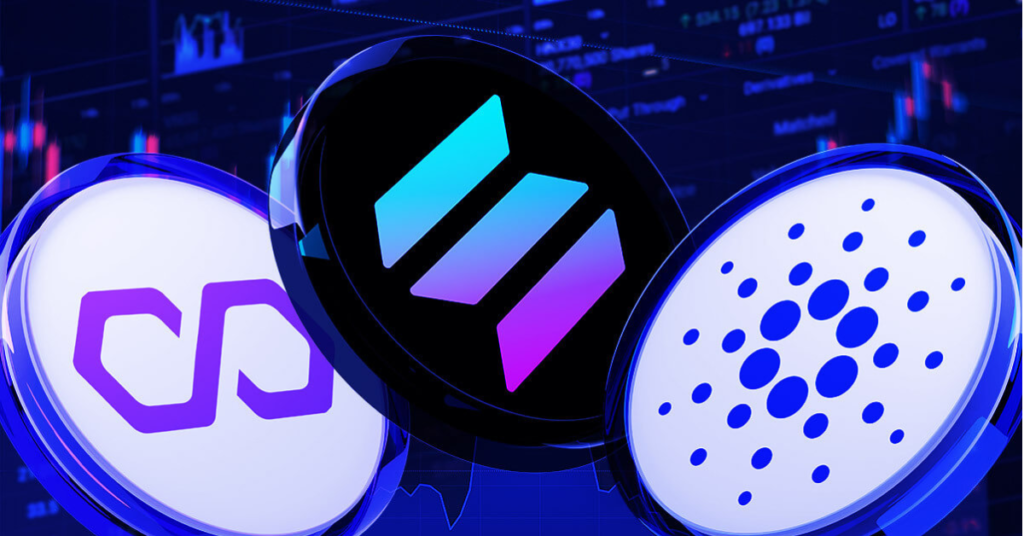Last updated on March 29th, 2024 at 04:02 pm
Solana (SOL) and Polygon (MATIC) are two high-performing cryptocurrencies. Polygon is currently ranked #9 at CoinMarketCap, with Solana tailing closely.
Should you sell your SOL and buy MATIC? This is a question many beginner investors ask, not knowing what could happen with these two cryptocurrencies in the future. This article will review the main benefits and risks of selling Solana and buying Polygon. That way, you will be able to decide whether a SOL to MATIC exchange is a good idea. Remember that your trading decisions should not be based on one source, and it’s your responsibility as a trader to check and compare a few opinions on the matter.
Table of Contents
Pros of Exchanging SOL for MATIC
First of all, we’ll see the two main benefits of making a SOL to MATIC swap, paying special attention to low transaction fees and technical capabilities.
Low Transaction Fees
It’s no secret: both Solana and Matic have low transaction fees. No matter which one you want, you will have to pay only a few cents (up to a few dollars) when making transactions. Solana indeed has a much better throughput, with around 65,000 transactions per second against Polygon’s 7,000, but both of these are great numbers. Yet, it’s safe to say that MATIC comes with a slightly lower transaction cost compared to its competitor.
Many other popular cryptocurrencies have low transaction fees. For instance, those swapping HBAR vs ALGO and many common trading pairs won’t have to pay much.
Technical Capabilities
Polygon is a revolutionary solution. A strong technical team established it to turn Ethereum into a multi-chain network by introducing optimistic rollups, ZK rollups, and more. In short, this project was a significant step forward in the mass adoption of the entire blockchain sphere. It’s safe to say that the platform has a bright future ahead, with the technical team being ready to innovate further and come up with new solutions for their ultimate goal.
Solana is also considered one of the technical innovators in the blockchain space, as it combined the Proof-of-Stake (POS) consensus mechanism with a novel technology called Proof-of-History (POH), offering a new and unique way to verify transactions.
Risks of SOL for MATIC Exchange
Exchanging SOL for MATIC also has some downsides we’d like to address. The two main ones are the limited use cases for MATIC and the volatility of both cryptocurrencies. Let’s take a look.
Limited Use Cases
Solana can support a wide range of applications and protocols, such as decentralized exchanges (DEXs), stablecoins, non-fungible tokens (NFTs), oracle networks, and more. Solana is overall a great platform for NFTs, as its speed and low fees are attractive for NFT creators and collectors.
Polygon also features a range of use cases. However, compared to Solana, the number is much lower. It mainly focuses on DeFi apps, offering financial services for farming, swapping, borrowing, and more. Moreover, Polygon also supports gaming and supply chain management industries.
Volatility
Both SOL and MATIC are volatile. Yet, by comparing the two coins’ price records, we can see that MATIC features higher fluctuations, which makes it a bit riskier compared to Solana. However, this also means that MATIC could have significantly higher returns. It’s important to do your own research and consider the risks before investing in either of these cryptocurrencies.
Swapping SOL to MATIC: Wait for the Right Time
Now that you know the main benefits and drawbacks, you must consider the right time to do the swap. Both cryptos are volatile, so it’s necessary to see when you can profit when exchanging.
You should study both markets and watch for trends to make an informed decision. Additionally, do not forget to consider the fees associated with the exchange. Finally, diversify your portfolio to minimize the risk of losses. Take time to understand the risks associated with trading in the markets. Invest only what you can afford to lose because crypto trading can be pretty tough at first. When you get the hang of it, you will be able to plan your crypto strategy and speculate on market changes.
Related Articles:
Integral Things To Know About Profit Sharing in Crypto No One Knows







